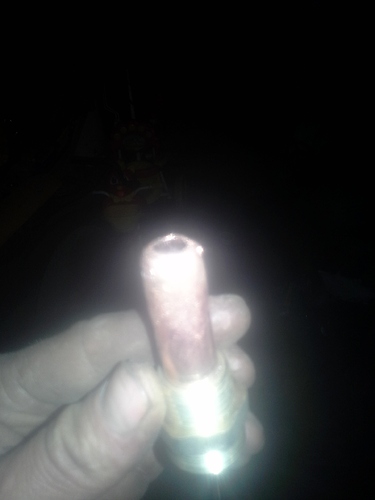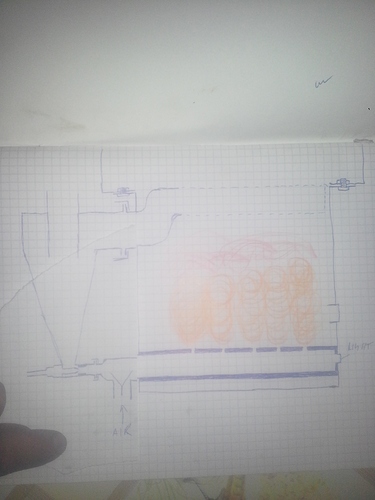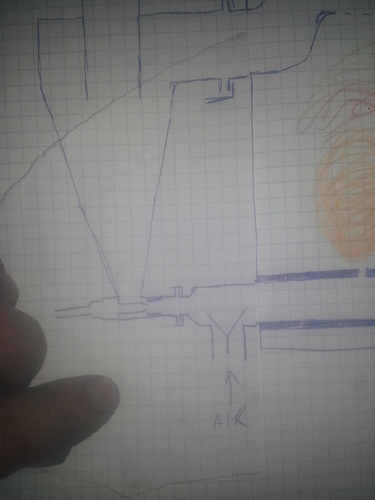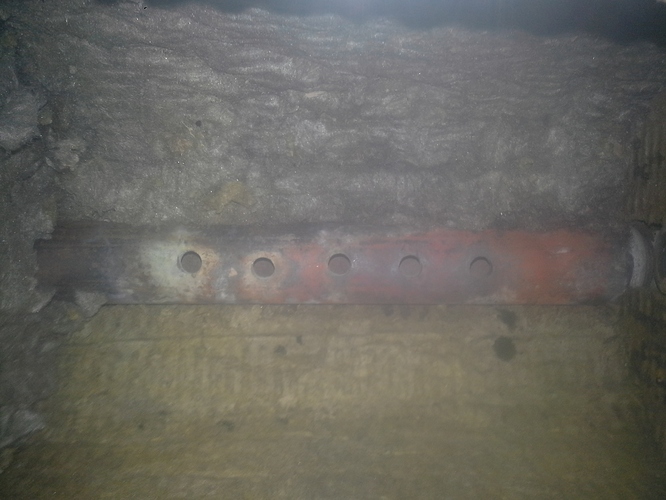If you want o save space, how about aluminium? Reflects heat good. Any auto part store sell “corrugated” soft sheets to wrap around starters for heat protection.
Rock wool tends to break down when exposed to enough heat. I suspect if used in that part of your system it would eventually turn into powder from the heat and vibration.
I have used wood ash as an insulator in retorts and in solid fuel cookstoves. Ash is light and fireproof.
Hmm not sure aluminium will survive. Its hell in there. Ss might! Or did you mean lineing it on the outside?
Til, good point on exhaust collecting! Will do one like that.
Garry, thats what l am afraid of too. I was thinking to sprincle it with some sodium silicate to firm it. No idea if it will work.
If nithing else, l will buy cheramic wool.
I did wery litle progress today, too windy for outside work. So, l only made the"wind sieve".
Exhaust nozzle
Nozzle screwed in on top, air intake visible underneeth. Non return flap missing.
Allso, Kevin asked for a skiz.
Allso, sometimes it doesent hurt to reread your own absorvations. I am reffering to the fact that on my Seat gasifier, the last 2 nozzles burned hotter thain the first. The fact is air bounces from the end of the nozzle pipe, causeing this effect. Same has been seen here and prooved later with a shopvac pushing air in.
You can see the right part is more oxidised. I will have to weld the last two tighter and drill the first two.
Will the nozzle be fed with positive exhaust pressure? How is a constant exhaust/air ratio achieved?
Yes but only a small volume of it. In general, exhaust is self metered. Bigger gas demand, bigger exhaust pressure, more exhaust injected. The size of the exhaust nozzle will however need to be adjusted, to determin just the right amount l went with l think 8mm for a start.
Hi Kristijan,
I’m just wondering if you have any clean out opening at the hearth or if you plan to remove the ashes and clinkers through your hopper?
Of course a cleaning opening in the “stealth mode” is not easy, but will maybe life easier in the long run. As it is similar to the Seat system, how often did you had to clean it there? I can remember photos from you and Bruce Southerland with clinker buildup at your nozzles.
Maybe this is the solution: Now your gasifier is clean with bare metal walls. Just let it run a certain time and let some ashes accumulate at the bottom. Doesn’t really work on the vertical side walls though.
After the test runs, have you noticed if the returned char particles settle somewhere at the bottom of your nozzle or are they all carried through the holes upwards?
Thanks much krisijan, am haveing trouble with the pic due too glare and would get a better perspective with the entire hopper and parts named, i never made it too skimatice class for welding. Thanks for the clearity when get time or are more done.
I like it Kristijan. The cyclone ash pickup/exhaust nozzle should work with the positive pressure. Get the holes drilled to the right size on your manifold nozzles and you will be good to go for another test run.
Bob
This may not help you with “used” high temperature insulation in your country . . . but in electric hydropower land self cleaning electric ovens have been popular for about 40 years.
To carbonize/burn reduce interior oven cooking debris to ash and these go into high over heat.
They are spun ceramic fiber insulated to prevent overheating fires into the surround kitchen cabinetry.
As factory baked-on enamel colored metals units these have a negative scrap value.
So free here for the taking.
A cheap source for very high temperature insulation.
And I find that I can use the wire rack/shelves for many things.
Regards
tree-farmer Steve unruh
Great tip on free insulation from self cleaning ovens!
Actually I’ve used ashes as insulation between an inner and outer barrel on a retort built especially to make pellet charcoal.
Wood pellet charcoal is the best, but it is a little expensive at $5 per 40 pounds of pellets. I now make charcoal from wood chips in the summer when I don’t have a use for the extra heat. In the winter, I make charcoal in my woodstove by putting pellets in a metal pot, then build a fire around it. I feel better about the cost when I can use the heat.
Thanks Steve, for the info on the oven insulation. I bought a bulk roll of ceramic insulation when I rebuilt the Dodge Dakota gasifier. I still have plenty left over to use on this gasifier, and others.
It’s to bad these ovens are not air tight. They would make a good gasifier with a window to watch the fire.
Bob
Til, there is no cleaning port. No space. As with the Seat gasifier, its all serviceable from sbove.
I cant remember the interval, but it lasted some time. Allso, l didnt use egr in that gasifier, meaning most of ash melted on the nozzles. Allso, l will use Bruces “nozzle poking rod” idea, clean the holes from underneeth.
I think l might get by with monthly cleanups here. Thats ok.
I didnt test the soot reintake yet. But my guess is most will fly trugh the nozzles, the rest that setles down will burn in the nozzle pipe. There is allways a glowing pile of char under each nozzle anyway.
Ash is a good insulator yes, but its the walls that are problematic. Bottom remains cold.
Thanks Steve, l think l have a old oven in the old house, maybee luck is on my side. Those ovens, called pirolisis ovens have only became popular in recent years here.
Bruce, pellets are similar price here, a tad expensiver. But like you sayd, l feel better too if l heat the greenhouse with the heat. And man they make some of that!
Allso, a question to char guys. I never run a egr in any of my char gasifiers much, so l havent got much idea how it all acts inside. Particulary, does egr shrink the hot reaction zone or expand it?
Logic says it cools/shrinks/lowers the gliwing mass of char, but on the other hand, since the zone us cooler, gas needs a longer time to get reduced fully, meaning a larger, but lower temp reaction glibe? What do you think?
I have EGR on my lawn tractor. I can look through the air inlet and see the reaction zone. Before I turn the valve to let in exhaust, the glow is white hot. After I open the valve, it turns orange and then red. I usually open the valve until I can see individual pieces of char dancing around the nozzle. It is much too bright to see that without EGR.
Regarding the reaction zone and EGR:
I can only offer an “academic” answer. I think the reaction zone shrinks. Why? Because if you don’t have EGR or steam, you create more heat in the oxidation zone than needed for the reduction. This heat must go somewhere, spread out, heat the gasifier walls, whatever.
In old publications, temps up to 2000°C are mentioned at cross-draft designs.
If you use EGR (Källe recommend enough added exhaust to lower the temp in the oxidation zone to 900 - 1000°C), there is less or no excessive heat. What is generated in the oxidation is consumed in the reduction (in the ideal world).
As there is nearly no reduction below 800°C, I don’t think that the reaction globe is expanding.
In practice, I think this is exactly what Don is reporting. The colour of the glowing char corresponds roughly to the temperatures mentioned above.
With added steam, it might be different. Steam has a very high heat capacity, so if you are not able to split all the water to hydrogen, the remaining steam will carry the heat out of your reaction zone and thus cause a hot gas outtake.
To make a proof of this theory, maybe try this: measure your gas outtake temp with and without EGR at the same load, for example full throttle or constant driving. If I’m right, you should get lower temps with EGR.
Well writen. This was my first and most obvious and logical thinking too. But, then l started thinking, in case of stright air intake, since the charcoal is so hot, the reaction happen allmost instantainiusly near the nozzle. Now, if the temperature falls to lets say 1000c, the reaction is slow, meaning the gas travels more distance trugh the charbed to dispose all its energy in a endothermic reactionn.
Well, either way, this is just theorerical curiousity. The real deal will show for sure. I hope l will manage to put it all together today, first l have to fix a few roofs that the 100kmh wind damaged tonight. The greenhouse suffered some damage too…
This is a good point. As you said, experience will show it.
I just want to add, that in the old publications I found the information that in a normal gasifier, the theoretical equilibrium (CO production related to temperature) is never reached. Several reasons are named, for example the short time (gases flow fast through the reaction zone, leaving just fractions of a second for the reaction), uneven temperature distribution in the hearth and the uneven distribution of gases and CO2/CO concentrations (for example due to channeling or different reactivity of the char or partly clogging with ash).
Sorry to hear about your storm damaged roofs. Hope you can fix it easily.
This conversation about EGR and water/steam is very interesting. EGR is more or less self regulating once set for the desired temperature. As load increases, exhaust increases. Water on the other hand needs to be regulated based on load. Most designs that I have seen either allow the reactor to draw in steam with air through a boiler that is open to the atmosphere OR use a water drip set to a rate that will not quench the reaction under low load conditions. I assume if we want to optimize the release of H from H2O, we need to regulate the flow based on load. The big question I have is about the relative relationship between EGR (CO2) and H2O and reaction temperature. As I search for the optimum H2O under load will I need to reduce or eliminate the EGR to keep the reaction temperature high enough to get the most H? Right now I set the EGR for a little higher temp, use a low setting on water to not pass steam on low load, then increase my water as the load increases. I’m trying to find the right trade offs for my road conditions on my commute. I haven’t got this figured out or tuned in yet.
It seems to me if we used a small carburetor to administer the water as Max suggested, it too would be self regulating once initial setting was established.




